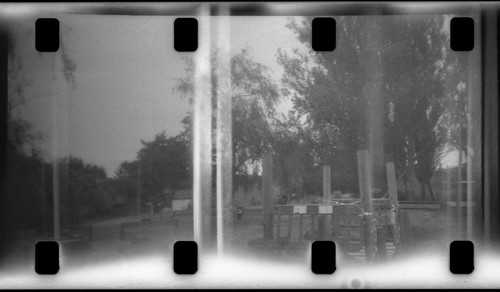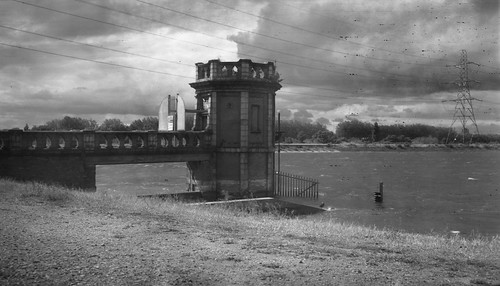 |
| Zeiss Ikon Cocarette with Kodak Verichrome Pan |
Last month, as well as shooting
126 film on the twelfth for 126 Day, I also shot several rolls of 116 format film the day before for a '
116 Day'. I used a
Zeiss Ikon Cocarette camera: in my post on the camera I wrote about how I had made some minor (and reversible) modifications to enable the camera to take 120 medium format rollfilm. On 116 Day in June, I undid these modifications in order to shoot 116 film, rather than 120. 116 film hasn't been made for over thirty years, and all the rolls of film I shot were much older than that. My expectations for the results were that I'd get something, but even if the film's emulsions had suffered from significant deterioration, I would at least have more 116 format backing paper for rolling with 120 film.
 |
| Ilford Selochrome Fast Ortho Film, September 1952 |
The first roll of film that I shot on the day was Ilford Selochrome 'Fast Ortho Film', was the oldest, with a date on the box of September 1952. Rating it at an exposure index of around 10, I also bracketed the shots, which I did with most of the shots on the day. I also used a tripod for most of the shots in this post, allowing for smaller apertures as a result of using longer exposure times than I would be comfortable hand-holding, although the weather was bright on 11th June in the UK when I took the photographs. As this Selochrome film was orthochromatic (there were also panchromatic versions of Selochrome), I tray developed it by inspection (using the 'see-saw' method) in Ilford Multigrade paper developer diluted 1+30. The negatives did need more exposure despite the bracketing; while developing the film, I could see that more development was just fogging the film however. After development, to get as much as I could from the film, I used a bath of selenium toner at a dilution of 1+9 to intensify the negatives.
 |
| Zeiss Ikon Cocarette with Ilford Selochrome Fast Ortho Film |
The emulsion had reacted with the backing paper, unsurprising perhaps with a 68-year old roll of film. The number markings show up in a regular pattern of dots, visible at bottom right in the image above, and across the top. Incidentally, the roll of Selochrome had a full range of 116 format numbers on the backing paper, something I've not encountered before - the usual numbers for 8 exposures at 6.5x11cm, but also 12 exposures for 6.5x6.5cm square, and 16 exposures for 5.5x6.5cm 'half-frame format'. This did of course mean that there was more printing for the emulsion to react to than other 116 backing papers (this - the film reacting to the printing on backing paper - is an issue which still plagues the odd batch of
new 120 film from time to time).
 |
| 616 format Kodak Plus-X, develop before October 1955 |
The next roll of film that I shot on the day was
616 format, not 116: 616 is to 116 what 620 was to 120. Kodak used the same film size and backing paper arrangement but on a slimmer spool, with narrower flanges at the ends. Although the winding key for the film is also smaller, the central hole in the spool itself is the same size as with 116, which means that a roll of 616 film should fit into the supply-side chamber of a 116 camera without any problems. The 616 film I shot was a roll of
Kodak Plus-X with a develop before date of October 1955. However, although the box was in good condition, this film had obviously been exposed to damp: the roll was wrapped in foil, and on unwrapping, one end of the metal spool had some visible corrosion. Advancing it through the camera, the film was very stiff, and needed a fair amount of force to get this onto the second frame; it also made a worrying noise when I advanced it. When it came to developing the film, I found that, for most of its length, it had stuck to the backing paper - although fortunately to the reverse of the film, not the emulsion side. Tearing it from the backing paper in a changing bag, once the tank was loaded, I found that the inside layer of the backing paper had mostly adhered to the film: a thin layer of backing paper remained surprisingly intact - the whole length of the roll, with the frame numberings (this film had two frame sizes on its backing paper - 8 exposures for 6.5x11cm, and 16 exposures for 5.5x6.5cm).
Although the second roll shot, this was the last that I developed, and seeing the results from the two rolls of Verichrome Pan, I
stand developed the Plus-X for three hours in Ilfotec LC29 diluted 1+100, agitating at the beginning and at the half-way mark. After development, and after thorough washing, but before fixing, I took the film of the developing reel and was able to remove the backing paper with some gentle rubbing.
 |
| Zeiss Ikon Cocarette with Kodak Plus-X |
Having had very low expectations of this film, there were images on it. In just a few areas, the emulsion had lifted, possibly from sticking to the backing paper (as above), and this did also have frame markings imprinted on the negatives, more clearly on some frames than others. In addition, there are what looks like some kind of water marks - I'm not sure what caused these - possibly, this might be due to developing the film while stuck to the backing paper, and the chemicals being unevenly absorbed - or, despite a thorough washing, the backing paper still had film developer absorbed into it when I removed it to clean off the paper (I did this in order that the fix wouldn't end up full of black paper fibres as a result).
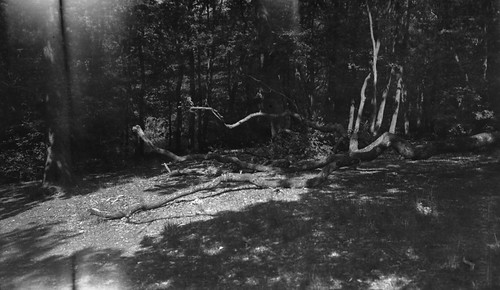 |
| Zeiss Ikon Cocarette with Kodak Plus-X |
The second frame also had creases across it - this was the point beyond which the backing paper had stuck to the film, and in forcing the film to advance, I had somehow gotten a fold running across the film - this is the frame above. One crease is clearly visible on the left of the frame: there is another just right of the centre, which is less visible. With all its problems, the 616 film also did not wind very tightly when advanced, resulting in some light leaks at the end of the film.
 |
| 116 format Kodak Verichrome Pan, develop before August/September 1965 |
The last two rolls of 116 film that I shot on the day were both
Kodak Verichrome Pan: one had a develop before date of August 1965, the other September 1965. These I'd bought as a single lot online, so possibly these two rolls of film had been bought at the same time in the early sixties, and had not been separated since. I have had some good results with Verichrome Pan of different ages, although not consistently so, and as these were a decade more recent than the other films, I had hopes that the emulsion might not have deteriorated as much. Incidentally, these have just one set of frame numberings on the backing paper, as I've found with other 116 film I've used - perhaps manufacturers abandoned printing numbers for the the less common formats as time when on. When I shot the films, I didn't note which was which, and the results were different - one roll had lots of tiny pinholes in the emulsion (showing as black specks); the other much less, but this one appears to have lots of small fibres (showing as irregular white flecks) stuck to the surface of the emulsion, although this patterning may be a reaction to the backing paper again. The first roll I stand developed for one hour in Ilfotec LC29 at a dilution of 1+100; the second I increased the time to 2 hours and 30 minutes. As the first roll had rather thin negatives, I again used selenium toner to intensify the negatives - the first image below is from this roll, as well as the image at the top of this post.
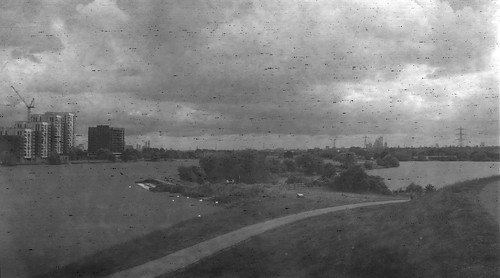 |
| Zeiss Ikon Cocarette with Kodak Verichrome Pan, showing pinholing |
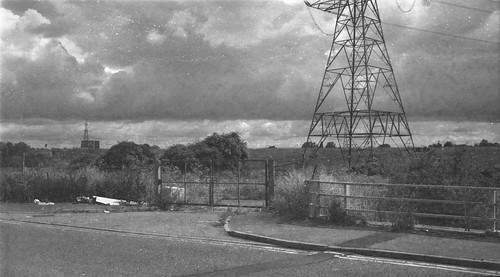 |
| Zeiss Ikon Cocarette with Kodak Verichrome Pan, showing white flecks |
For landscape work, I find the proportions of the 6.5x11cm frame attractive: this might be the primary reason for continuing to use 116 format cameras. Short of investing in some 70mm-wide film to respool with the backing paper, using 120 film does work well enough, as I have done previously, although this crops some of the image from the top and bottom of the frame. When the 116 format was introduced at the very end of the 19th century, negatives would usually have been contact-printed, as with the other rollfilm formats of the time, driving the demand for the relatively large negative size; I frequently use 'expired' film, and, taking into account all the inherent problems of doing so, the results of the films shot on 116 Day go some way to demonstrating the possibilities of the large 6.5x11cm frame.
 |
| Zeiss Ikon Cocarette with Ilford Selochrome Fast Ortho Film |
 |
| Zeiss Ikon Cocarette with Ilford Selochrome Fast Ortho Film |
 |
| Zeiss Ikon Cocarette with Kodak Plus-X |
 |
| Zeiss Ikon Cocarette with Kodak Plus-X |
 |
| Zeiss Ikon Cocarette with Kodak Verichrome Pan |
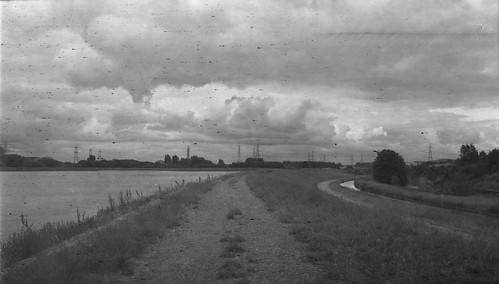 |
| Zeiss Ikon Cocarette with Kodak Verichrome Pan |
 |
| Zeiss Ikon Cocarette with Kodak Verichrome Pan |


